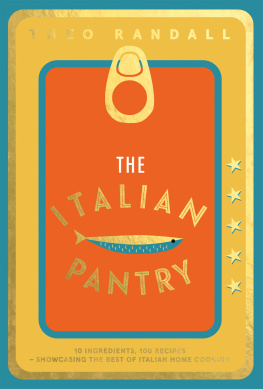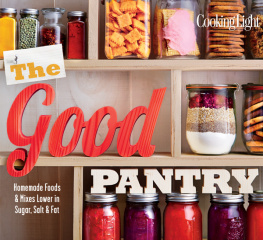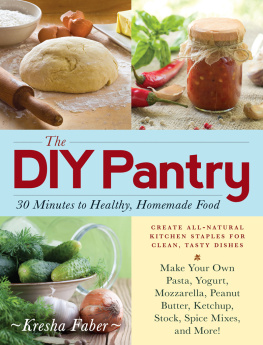I dedicate this book to
Prarthana, Ajit, Manasvini, Krishna,
Ananya and Kavya,
who, I hope will use all these staples
in the future and become smart cooks .
Foreword
I deem it a privilege to write a foreword for my friend Usha Sridhar for her OPOS Pantry Staples cookbook.
Working in the shadows of a mother who is world famous and a celebrity of sorts to the OPOS community can be daunting, but Usha has used the experience very wisely. Planning ahead, is THE key to mastering the OPOS technique and who better than her to give us a book on OPOS pantry staples. With this book, Im sure we can all become Master Chefs!!
Her methodical approach to the science of OPOS cooking has been beautifully displayed in the way she has come out with grits and other small tricks and tips. Her meticulous work is also very evident in the Ask ChitVish App, which is a great boon to all aspiring chefs. I wish Usha lots of luck with her second OPOS baby.
Ranjani Rajaram
Cookbook Author
About the book
The ease of cooking, which OPOS enables is mainly due to the staples that are prepared ahead of the actual cooking. To have a ready reckoner of such staples in one book, will make OPOS cooking an enjoyable experience. This book carries recipes of pantry staples that are required in cooking using the OPOS technique. Some of the staples themselves are made using the OPOS method and some are not.
Anything repeatedly used across recipes is, defined as an OPOS Staple. These are building blocks of cuisines. Many of these are commercially available. This book will cover staples that are used further in cooking in some way and not the final product itself. The key staples are cooked dal, tamarind paste, ginger garlic paste, bottled tadka and roasted spice powders.
Bottled tadkas can be cuisine specific. Garlic tadka in Konkani cuisine, panch phoran in East Indian cuisine, Cumin tadka in North Indian cuisine, mustard tadka in South Indian cuisine, cinnamon-clove-bay leaf tadka in Mughal cuisine are all Staples.
I hope this book will help every OPOS cook, save time and energy and make them smart cooks!
About the author
Usha learnt cooking from her mother and grandmother like all other Indian girls - only her mother
happened to be Chithra Viswanathan! Just putting together the app for ChitVish gave her a wealth of
knowledge in cooking.
She loves to try her hand at different types of cooking and different cuisines. This book is an effort to
pass on and share the legacy of her inheritance with all her friends, and make cooking a pleasure.
This is her second cookbook, the first being Everything Vegetable-OPOS Cookbook which figured
as Number 2 on the Amazon Kindle Store Best seller list.
Table of Contents
OPOS Primer
1. The OPOS Magic:
15 years, 780 blog posts, 26097 volunteers, 52 children, tons of provisions, 1208 files, 10411 Facebook posts, 5601 photos, 320 videos, millions of arguments, 1 dictator, 15 comedians, 1 world record, 4 restaurants, 16 chefs, 14 events and 22 corporate demos have gone into creating the OPOS magic. You now hold the key to this magical world!
2. What is OPOS?
OPOS (One Pot, One Shot) is a set of scientific cooking techniques designed to unchain you from the kitchen, cut drudgery and empower anyone to cook confidently. All OPOS recipes use One Pot and all cooking is done at One Shot. No steps. No supervision. From Pastas to Paneer Makhni, Malai Kofta to Mysorepak, OPOS recipes are easier and faster than cooking instant noodles!
3. The OPOS Promise:
OPOS is the cleanest, greenest, healthiest, tastiest and fastest way to cook just about anything.
OPOS works for anyone, anywhere, anytime.
4. Why OPOS?
OPOS is Green. One pot to wash.
OPOS is Clean. Hygienic. Less mess.
OPOS is Fast. Fresh food in minutes.
OPOS is Liberating. No supervision.
OPOS is Healthy. Maximises nutrition.
OPOS is Flexible. Cook your way.
OPOS is Economical. Saves fuel and water.
OPOS is Tasty. Intense flavours.
OPOS is Transparent. Works for all.
OPOS is Consistent. Works every time.
OPOS is Universal. Cooks all cuisines!
5. Tried and Tested:
Every single OPOS recipe is debated, tested, fine-tuned and validated hundreds of times by members of United By Food and OPOS School Facebook groups. The work of this passionate group of doctors, nutritionists, dietitians, bloggers, authors, chefs, food stylists, artists, homemakers, actors, scientists, caterers and many others continues to shape OPOS.
6. I was always OPOSing!
OPOS is not a fancy word for pressure cooking. Very few OPOS recipes follow the "Dump all into a cooker" technique. Most OPOS recipes skip water, use high heat, layering, precise measures and a combination of 26 techniques listed below. These techniques are responsible for the intense taste, textures, colours and flavours of OPOSed dishes.
7. OPOS Techniques:
Attalysis, Bottled tadka, Controlled evaporation, Dum cooking, Emulsification, Flash Cooking, Grits, Hydro distillation, Inner pot cooking, Just enough liquid, Key building blocks, Layering, MPOS, No Prep, Oil free, Pyrolysis, Queuing, Retained heat, Sugar Syrup hack, Turbo flavours, Use : of cooked bases, Very Long Marination, Waterless cooking, Xtra long storage, Yolk colour retention and Zoned flashing.
8. OPOS vs. Tradition:
Traditional recipes were not designed for todays lifestyle. Many of us lack the time, skill and support to make traditional recipes work. OPOS replaces manual skill with the right equipment and technique. OPOS standardises cooking conditions to make all recipes work the same way for anyone, anywhere, anytime. Use: right equipment and follow recipes to experience magic!
9. Equipment needed:
A 2 liter pressure Indian cooker. Measuring cups and spoons. Knife, peeler and grater. Kitchen scale. A stick blender. Heat source (Gas/Induction preferred, electric stoves are sluggish and need preheating). With OPOS, this is the only kitchen you need to feed a small family!
10. Measures:
Use : standard measuring cups, spoons (1C = 240 ml, 1tsp = 5 ml, 1tbsp = 15 ml) and a kitchen scale. Use measuring cups for liquids and weighing scale for solids, especially in tricky recipes like sugar syrup.
11. Shopping list:
Starch: Rice, Poha, Vermicelli, Pasta, Noodles, Puffed rice, Rava, Wheat flour, Rice flour, Millets, Oats, Sago.
Protein: Tur dal, Mung dal, Channa dal, Chickpeas, Kidney beans, Green Peas, Gram flour, Roasted gram, Soya chunks, Whole moong, Sprouts, Paneer, Mushroom, Chicken, Mutton, other meats, Fish, Seafood and Eggs.
Micronutrients: Onion, Tomato, Fresh vegetables, Spinach.
Fats: Ghee, Virgin oils (Sesame, Coconut, Peanut), Mustard oil, Refined vegetable Oils
Dairy: Butter, Cream, Milk, Yogurt, Condensed milk.
12. Shopping List 2:
Spice Box: Garam masala, Chilli, Coriander, Cumin, Turmeric, Asafoetida, Sambar, Pepper powders. Mustard, Cumin, Fenugreek, Fennel seeds. Cardamom, Cinnamon, Bay leaf, Cloves, Ginger, Garlic, fenugreek, Urad dal, Dry red chilli.
Essentials: Salt, Sugar, Pickles, Papad, Tamarind, Coconut, Chilli, Coconut milk, Coconut milk powder, Cashew, Peanuts.
Optional: Cheese, Almonds, Raisins, Sesame, Saffron, Cinnamon, Italian seasoning.
13. Bigger is not better!
The tiny 2L cooker can cook breakfast/lunch/dinner (Pongal/Upma/Rice, Biriyani/Pasta/Noodles/Porridge) for 2, Dry/Wet curries/Soups for 4, Starters (Fondue/Stuffed vegetables/Kadai paneer/Pindi channa/Pepper chicken) for 5, Pickles/Jam/Desserts for 10 and Hard boiled eggs for 15. The best part is, it can cook all the above in 5 to 10 minutes!








